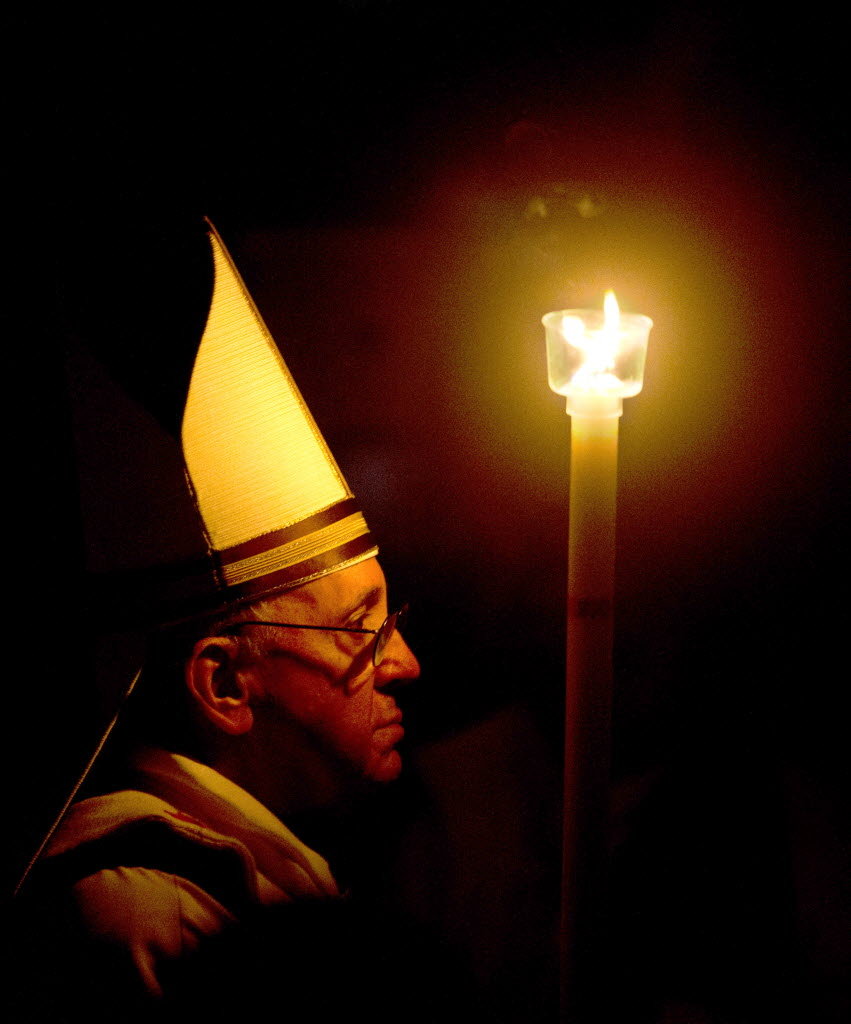What’s the connection between the Old Covenant High Priesthood and Papal Infallibility? Today’s Gospel sheds some light. Don’t forget to share this post, and subscribe to our YouTube Channel!
Posts

Q. This Sunday’s Gospel is taken from John 21. Does this chapter have any implications for the papacy?
A. Other texts, like Matthew 16, are often cited in this regard, but John 21 has one of the strongest proofs for the ongoing role of the office of Peter in the universal Church. Even non-Catholic scholars recognize this.
Q. Does the miraculous catch of fish in this chapter have anything to do with the Petrine office?
A. Fishing, of course, wasn’t just the former trade of the apostles; it represents their evangelistic mission of being “fishers of men”. The unbroken net conveys the unity of the one Catholic (universal) Church. Elsewhere, when Jesus provides a miraculous draught of fish, the nets begin to break from the strain; here, the nets are intact. Peter, dragging the net ashore, evokes his leadership in bringing the Church safely home to Christ, even to the shores of Heaven itself.
Interestingly, although the catch was so big that the disciples struggled to bring the nets aboard, almost sinking their boat, Peter now easily drags the net ashore all by himself. The Greek verb in the original text that is used to describe Peter’s dragging of the net is the same one used by Jesus in John 12:32. This is where Jesus says that, as he is lifted up from the earth, he will draw all people to himself.
Q. Why does the text mention specifically that 153 fish were caught?
A. By far, the most puzzling aspect of the passage is the reference to the 153 fish. First of all, this is an authentic eyewitness detail. On a secondary level, many commentators have proffered various theories to explain what this number might symbolize (John’s Gospel functions on “two levels” – there is often a secondary, “heavenly” meaning to earthly events). Most of these interpretations suggest the idea of the universality or completeness of the catch.
So, to sum up: we have Peter, alone, dragging the unbroken net of a universal catch to the shores of heaven. This is clearly a reference to his position as leader of the Church on earth.
When you add to all of this the threefold charge of Jesus to Peter (“Feed my Sheep”) that immediately follows, the picture is complete. Peter is singularly (in the original Greek text) given this responsibility to shepherd the universal Church. Keep in mind also that this event is recounted in the same Gospel in which Jesus describes himself as the “Good Shepherd” (John 10). Before his Ascension, Jesus here reaffirms Peter’s unique leadership position, passing the earthly reins of the Church to him.
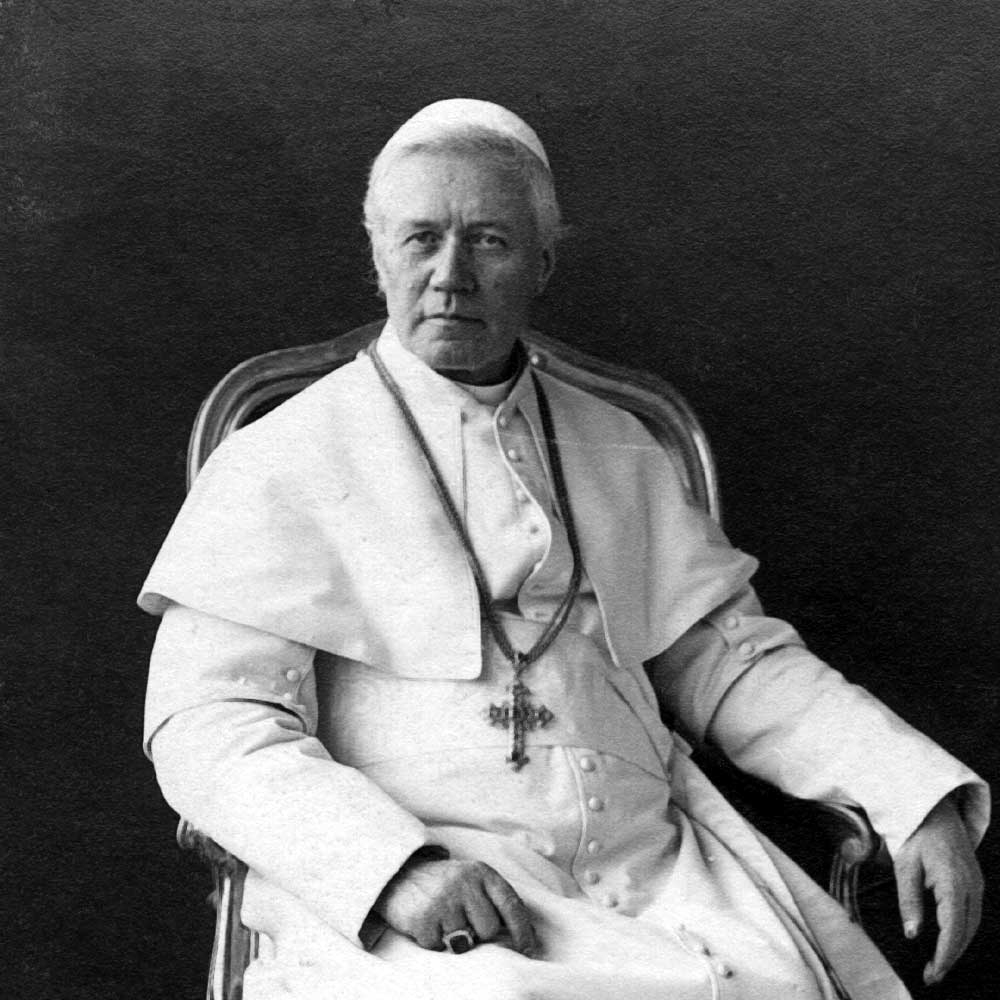 Today marks the feast day of Pope St Pius X, who occupied the See of Peter from 1903-1914. One of St Pius’ great reforms was to lower the age of first communicants to the age of reason (usually considered to be around eight years old). As long as a child believed that the Eucharist was the Body, Blood, Soul, and Divinity of Jesus Christ – hidden under the appearances of bread and wine, that child could receive communion. This is a great thing, because it reminds us that we can be sure a doctrine is true, without necessarily having complete and total understanding of it.
Today marks the feast day of Pope St Pius X, who occupied the See of Peter from 1903-1914. One of St Pius’ great reforms was to lower the age of first communicants to the age of reason (usually considered to be around eight years old). As long as a child believed that the Eucharist was the Body, Blood, Soul, and Divinity of Jesus Christ – hidden under the appearances of bread and wine, that child could receive communion. This is a great thing, because it reminds us that we can be sure a doctrine is true, without necessarily having complete and total understanding of it.
For example, no one, not even the greatest theologian, completely understands the doctrine of the Trinity. And anyone who says they do is mistaken, for no one has complete understanding of the uncreated, three-in-one Godhead crammed inside one’s feeble, created mind. Yet, every Catholic can be sure it is true that God is a Trinity of Persons, because it has been divinely revealed. In the same way, I believe and know that electricity works. I have certitude about it, even though I’m not a professional electrician and can’t explain the circuitry and currents involved. For me to benefit from it, I simply need to make an act of faith in what I know to be true – by turning on the light.
One of the reasons I left the Catholic Church as a twentysomething university student was that I could never get a satisfying answer from the Catholics I knew about why certain doctrines were true. I thought this was evidence of the weakness of the faith. In reality, I was, of course, making an elementary error in thinking that, simply because a religious adherent couldn’t explain a tenet of their faith, it therefore follows that it is not true.
Although we should, as the original Pope, St Peter, encourages us, “make every effort to add to (our) faith…knowledge” (2 Peter 1:5), one can still have certitude about these things, even if we don’t have perfect knowledge of them. Why? Because we have a divinely authorized Church to teach them to us – and we need this. If each of us had to reason our own way to saving knowledge of God by ourselves, we’d be in trouble, easily led astray. God foreknew this, providing us with a Church that would be Mater et Magistra (Mother and Teacher), safeguarding Jesus’ teachings until the end of time. We thank our Lord for this today, and for providing his Church with great spiritual fathers like St Pius X.
What do you think? Share this post on Facebook, Twitter, and LinkedIn.
You may also like: Pope Pius X and the Immaculate Conception
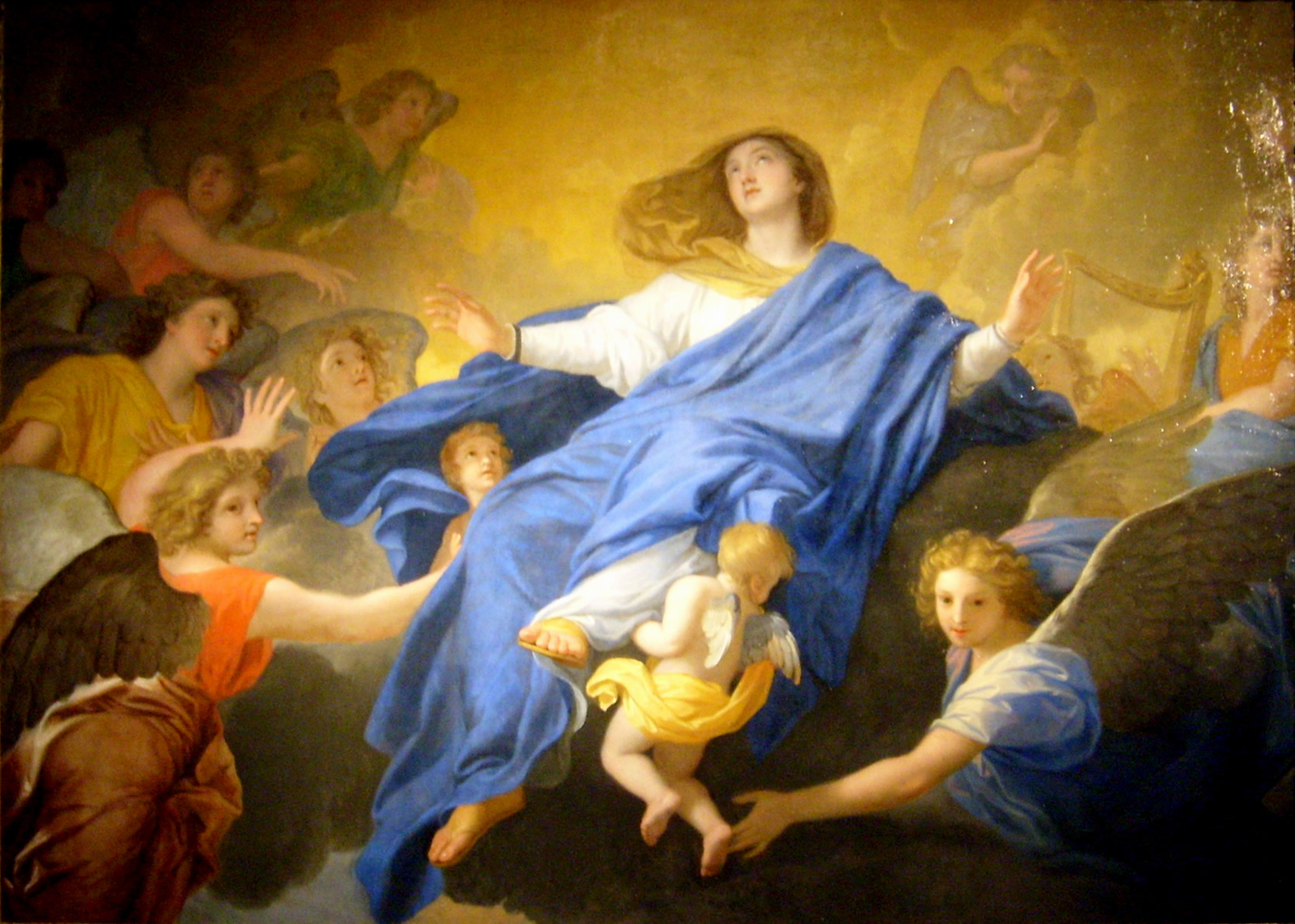 Today is the Solemnity of the Assumption of Mary, celebrating that God raised the Virgin Mary, body and soul, to the glories of heaven at the end of her earthly journey. Here are four quick facts about this teaching of the Church :
Today is the Solemnity of the Assumption of Mary, celebrating that God raised the Virgin Mary, body and soul, to the glories of heaven at the end of her earthly journey. Here are four quick facts about this teaching of the Church :
1. Catholics must believe this in order to hold the Faith.
The Assumption of Mary is one of the four Marian Dogmas (infallible teachings) that Catholics must believe (the others being the Immaculate Conception, Divine Maternity, and Perpetual Virginity of our Lady). The reason why validity of the doctrine can be trusted is that it rests on the same foundation as that of Transubstantiation or the Canon of the Bible – namely, the teaching authority of the Catholic Church.
2. There is good circumstantial, supporting evidence for the Assumption.
No Christian community has ever claimed to have the relics (bones or other mortal remains) of the Virgin Mary. When one considers how Christians venerated the relics and final resting places of important saints in the early Church period (such as St Peter’s Basilica being built over his tomb), it is remarkable that no church has ever claimed to have her relics. If the relics of the Mother of Jesus relics really did exist, they would have been prized above all others. An argument from silence isn’t always the greatest, but in this case, silence speaks volumes.
3. There is indirect, biblical support for the doctrine.
The simple fact of the matter is that, in salvation history recorded in the Bible, “assumptions happen”. Genesis speaks of Enoch, who “walked with God and was no more, because God took him” (Genesis 5:24; cf. Hebrews 11:5). Most interpreters believe that Enoch was assumed, body and soul, into heaven. Also, Elijah was taken up to heaven, body and soul, in a chariot of fire (2 Kings 2:11).
If these holy ones of old could be translated directly to heaven, why not the “Panagia” (“All-Holy”) mother of God, who “gave the Word flesh” (cf. John 1:14)? In Revelation 12, John sees the “Ark of the (New) Covenant”, Mary in heaven.
4. Christians have believed this for centuries.
Catholics did not “invent” the doctrine of the Assumption when Pope Pius XII officially defined it in 1950. All the Pope was doing was making clear that this teaching was always true and part of the deposit of faith (Jude 3) for centuries. How do we know this? Because the Church’s liturgy (including the content of liturgical prayers and feast days) included the Assumption from the earliest times. Some even believe it was the earliest of Marian feast days, originating in Jerusalem.
Many Christian practices were suppressed under the wicked reign of Emperor Hadrian, who had levelled much of Jerusalem in 135 AD, renaming the town after the pagan god Jupiter. After Constantine’s acceptance of the faith in the fourth century, many Christian feasts were revived. The Assumption began to be celebrated in Rome as early as the seventh century. It is in the liturgy that Sacred Tradition is taught most clearly, for “the Church believes as She prays” (Lex orandi, lex credendi).
We have a powerful intercessor in heaven in Mary, who precedes all of us who look forward to life in the new heaven and the new earth in a glorified humanity of body and soul. We close with a liturgical prayer asking for that intercession: Recordare, Virgo Mater Dei, dum steteris in conspectu Domini; ut loquaris pro nobis bona (“Remember, Virgin Mother of God, when you walk in the presence of the Lord, to speak well of us”).
Here is the English translation of Pope Francis’ homily from tonight’s Easter vigil in St Peter’s Basilica, Rome. Happy Easter, everyone! Christ is risen! Alleluia!
Tonight is a night of vigil. The Lord is not sleeping; the Watchman is watching over his people (cf. Ps 121:4), to bring them out of slavery and to open before them the way to freedom.
The Lord is keeping watch and, by the power of his love, he is bringing his people through the Red Sea. He is also bringing Jesus through the abyss of death and the netherworld.
This was a night of vigil for the disciples of Jesus, a night of sadness and fear. The men remained locked in the Upper Room. Yet, the women went to the tomb at dawn on Sunday to anoint Jesus’ body. Their hearts were overwhelmed and they were asking themselves: “How will we enter? Who will roll back the stone of the tomb?…” But here was the first sign of the great event: the large stone was already rolled back and the tomb was open!
“Entering the tomb, they saw a young man sitting on the right side, dressed in a white robe…” (Mk 16:5). The women were the first to see this great sign, the empty tomb; and they were the first to enter…
“Entering the tomb”. It is good for us, on this Vigil night, to reflect on the experience of the women, which also speaks to us. For that is why we are here: to enter, to enter into the Mystery which God has accomplished with his vigil of love.
We cannot live Easter without entering into the mystery. It is not something intellectual, something we only know or read about… It is more, much more!
“To enter into the mystery” means the ability to wonder, to contemplate; the ability to listen to the silence and to hear the tiny whisper amid great silence by which God speaks to us (cf 1 Kings 19:12).
To enter into the mystery demands that we not be afraid of reality: that we not be locked into ourselves, that we not flee from what we fail to understand, that we not close our eyes to problems or deny them, that we not dismiss our questions…
To enter into the mystery means going beyond our own comfort zone, beyond the laziness and indifference which hold us back, and going out in search of truth, beauty and love. It is seeking a deeper meaning, an answer, and not an easy one, to the questions which challenge our faith, our fidelity and our very existence.
To enter into the mystery, we need humility, the lowliness to abase ourselves, to come down from the pedestal of our “I” which is so proud, of our presumption; the humility not to take ourselves so seriously, recognizing who we really are: creatures with strengths and weaknesses, sinners in need of forgiveness. To enter into the mystery we need the lowliness that is powerlessness, the renunciation of our idols… in a word, we need to adore. Without adoration, we cannot enter into the mystery.
The women who were Jesus’ disciples teach us all of this. They kept watch that night, together with Mary. And she, the Virgin Mother, helped them not to lose faith and hope. As a result, they did not remain prisoners of fear and sadness, but at the first light of dawn they went out carrying their ointments, their hearts anointed with love. They went forth and found the tomb open. And they went in. They had kept watch, they went forth and they entered into the Mystery. May we learn from them to keep watch with God and with Mary our Mother, so that we too may enter into the Mystery which leads from death to life.
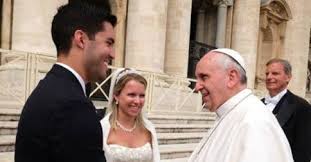 Q. I have heard many pundits from the MSM (mainstream media) declare that Pope Francis wants to redefine marriage. Is this true?
Q. I have heard many pundits from the MSM (mainstream media) declare that Pope Francis wants to redefine marriage. Is this true?
A. No, this is simply not the case. People who say these things are clearly not reading the Pope’s actual writings on this issue, or paying any attention to his homilies. That Pope Francis wishes to uphold Catholic teaching on sexual morality and marriage (which cannot be changed, at any rate) should have been abundantly clear when the Pontiff beatified his predecessor, Paul VI, at the conclusion of the recent Synod on the family. Pope Paul VI himself suffered greatly because of his defense of marriage, and is a personal hero to Pope Francis.
Q. What did Pope Francis say in his opening remarks at the Colloquium on the Complementarity of Man and Woman this past week at the Vatican?
A. This is a very important conference indeed. What stood out to me in particular was the brilliant connection the Pontiff drew between marriage and ecology. In a world where so many people are (quite rightly) concerned about the environment, it is so often forgotten that the “environment” of human society is the family. As the Holy Father said, “we must foster a new human ecology” by strengthening marriage. Here is a great quote from his speech (translated from the original Italian):
“We know that today marriage and the family are in crisis. We now live in a culture of the temporary, in which more and more people are simply giving up on marriage as a public commitment. This revolution in manners and morals has often flown the flag of freedom, but in fact it has brought spiritual and material devastation to countless human beings, especially the poorest and most vulnerable.
“Evidence is mounting that the decline of the marriage culture is associated with increased poverty and a host of other social ills, disproportionately affecting women, children and the elderly. It is always they who suffer the most in this crisis.
“The crisis in the family has produced an ecological crisis, for social environments, like natural environments, need protection. And although the human race has come to understand the need to address conditions that menace our natural environments, we have been slower to recognize that our fragile social environments are under threat as well, slower in our culture, and also in our Catholic Church. It is therefore essential that we foster a new human ecology.”
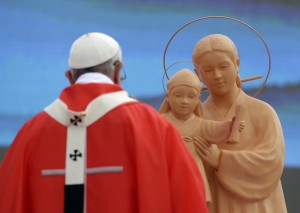 The Holy Father highlights the need for reconciliation, which is of particular concern for the future of the Korean peninsula.
The Holy Father highlights the need for reconciliation, which is of particular concern for the future of the Korean peninsula.
Dear Brothers and Sisters,
As my stay in Korea draws to a close, I thank God for the many blessings he has bestowed upon this beloved country, and in a special way, upon the Church in Korea. Among those blessings I especially treasure the experience we have all had in these recent days of the presence of so many young pilgrims from throughout Asia. Their love of Jesus and their enthusiasm for the spread of his Kingdom have been an inspiration to us all.
My visit now culminates in this celebration of Mass, in which we implore from God the grace of peace and reconciliation. This prayer has a particular resonance on the Korean peninsula. Today’s Mass is first and foremost a prayer for reconciliation in this Korean family. In the Gospel, Jesus tells us how powerful is our prayer when two or three of us join in asking for something (cf. Mt 18:19-20). How much more when an entire people raises its heartfelt plea to heaven!
The first reading presents God’s promise to restore to unity and prosperity a people dispersed by disaster and division. For us, as for the people of Israel, this is a promise full of hope: it points to a future which God is even now preparing for us. Yet this promise is inseparably tied to a command: the command to return to God and wholeheartedly obey his law (cf. Dt 30:2-3). God’s gifts of reconciliation, unity and peace are inseparably linked to the grace of conversion, a change of heart which can alter the course of our lives and our history, as individuals and as a people.
At this Mass, we naturally hear this promise in the context of the historical experience of the Korean people, an experience of division and conflict which has lasted for well over sixty years. But God’s urgent summons to conversion also challenges Christ’s followers in Korea to examine the quality of their own contribution to the building of a truly just and humane society. It challenges each of you to reflect on the extent to which you, as individuals and communities, show evangelical concern for the less fortunate, the marginalized, those without work and those who do not share in the prosperity of the many. And it challenges you, as Christians and Koreans, firmly to reject a mindset shaped by suspicion, confrontation and competition, and instead to shape a culture formed by the teaching of the Gospel and the noblest traditional values of the Korean people.
In today’s Gospel, Peter asks the Lord: If my brother sins against me, how often must I forgive him? As many as seven times? To which the Lord replies: Not seven times, I tell you, but seventy times seven (Mt 18:21-22). These words go to the very heart of Jesus message of reconciliation and peace. In obedience to his command, we ask our heavenly Father daily to forgive us our sins, as we forgive those who sin against us. Unless we are prepared to do this, how can we honestly pray for peace and reconciliation?
Jesus asks us to believe that forgiveness is the door which leads to reconciliation. In telling us to forgive our brothers unreservedly, he is asking us to do something utterly radical, but he also gives us the grace to do it. What appears, from a human perspective, to be impossible, impractical and even at times repugnant, he makes possible and fruitful through the infinite power of his cross. The cross of Christ reveals the power of God to bridge every division, to heal every wound, and to reestablish the original bonds of brotherly love.
This, then, is the message which I leave you as I conclude my visit to Korea. Trust in the power of Christ’s cross! Welcome its reconciling grace into your own hearts and share that grace with others! I ask you to bear convincing witness to Christ’s message of forgiveness in your homes, in your communities and at every level of national life. I am confident that, in a spirit of friendship and cooperation with other Christians, with the followers of other religions, and with all men and women of good will concerned for the future of Korean society, you will be a leaven of the Kingdom of God in this land. Thus our prayers for peace and reconciliation will rise to God from ever more pure hearts and, by his gracious gift, obtain that precious good for which we all long.
Let us pray, then, for the emergence of new opportunities for dialogue, encounter and the resolution of differences, for continued generosity in providing humanitarian assistance to those in need, and for an ever greater recognition that all Koreans are brothers and sisters, members of one family, one people.
Before leaving Korea, I wish to thank the President of the Republic, the civil and ecclesiastical authorities and all those who in any way helped to make this visit possible. I especially wish to address a word of personal appreciation to the priests of Korea, who daily labor in the service of the Gospel and the building up of God’s people in faith, hope and love. I ask you, as ambassadors of Christ and ministers of his reconciling love (cf. 2 Cor 5:18-20), to continue to build bridges of respect, trust and harmonious cooperation in your parishes, among yourselves, and with your bishops. Your example of unreserved love for the Lord, your faithfulness and dedication to your ministry, and your charitable concern for those in need, contribute greatly to the work of reconciliation and peace in this country.
Dear brothers and sisters, God calls us to return to him and to hearken to his voice, and he promises to establish us on the land in even greater peace and prosperity than our ancestors knew. May Christ’s followers in Korea prepare for the dawning of that new day, when this land of the morning calm will rejoice in God’s richest blessings of harmony and peace!
Amen.

Pope Pius IX, who defined the Dogma of the Immaculate Conception (1854)
Today’s great Solemnity of the Immaculate conception of Mary is usually celebrated on December 8. However, due to the second Sunday of Advent falling on that date yesterday, the Solemnity was communicated to today this year. And it’s certainly a doctrine that is misunderstood by many.
The Immaculate Conception is not the Virginal Conception of Jesus. Nor does it have anything to do with this, sports fans.
Here’s the actual definition, from Blessed Pope Pius IX, “Pio Nono”:
We declare, pronounce, and define that the doctrine which holds that the most Blessed Virgin Mary, in the first instance of her conception, by a singular grace and privilege granted by Almighty God, in view of the merits of Jesus Christ, the Savior of the human race, was preserved free from all stain of original sin, is a doctrine revealed by God and therefore to be believed firmly and constantly by all the faithful.
–Ineffabilis Deus, Apostolic Constitution of Pope Pius IX solemnly defining the dogma of the Immaculate Conception, 8 December 1854.
the basis for the Immaculate Conception of Mary in the New Testament is well-known, but today I’d like to share about one of the ways the doctrine is foreshadowed in the Old Testament. In his masterful devotional series, In Conversation with God, Francis Fernandez writes about Mary as the new Temple in which God dwells:
In the litany of Loreto we call upon Mary, House of Gold, the abode of greatest conceivable splendor. When a family turns a house into a home by taking up residence there, the place reflects the individual qualities of the people. They accentuate the beauty of the dwelling place. Just like the Holy Spirit dwelling in Our Lady, the home and its inhabitants make up a particular unity, in much the same way as the body and its garments do. The foremost Tabernacle in the Old Testament, later to be the Temple, is the House of God, where the meeting of Yahweh and his people takes place. When Solomon makes the decision to build the Temple, the Prophets specify that the best available materials are to be used – abundant cedar wood on the inside and clad with gold on the outside. The most highly skilled craftsmen are to work on its construction.
Before God made known his coming into the world in the fullness of time, He prepared Mary as the suitable creature within whom He would dwell for nine months, from the moment of his Incarnation until his birth in Bethlehem. Evidence of God’s power and love show forth in his creation. Mary is the House of Gold, the new Temple of God, and is adorned with so great a beauty that no greater perfection is possible. The grace of her Immaculate Conception, including all the graces and gifts God ever bestowed on her soul, are directed towards the fulfillment of her divine Maternity.
God’s gift of supernatural life to her exceeds that of all the Apostles, Martyrs, Confessors and Virgins combined. It reaches far beyond the experience of anyone who has ever lived, or ever will live, until the end of time. God dwells in Our Lady more than in all the angels and saints, since the foundation of the world, taken together. Truly God has prepared a human vessel in keeping with the dignity of his eternal Son. When we say that Mary has an almost infinite dignity, we mean that among all God’s creatures she is the one who enjoys the most intimate relationship with the Blessed Trinity. Her absolute honor is the highest possible and her majesty is in every way unique. She is the firstborn and most highly favored daughter of the Father, as she has often been called throughout the history of the Church, and as has been reiterated by the Second Vatican Council, Our Lady’s blood relationship with Jesus Christ, the Son of God, leads her to a singular relationship with him.
Mary is indeed the new Temple and Tabernacle of God.


